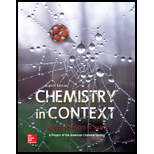
Concept explainers
(a)
Interpretation:
The production of electricity from wind and nuclear energy has to be compared.
Concept Introduction:
The major share of electricity consumed by the world is obtained through nuclear power plants. Even though nuclear power plants are clean energy sources, the disposal of hazardous radioactive waste produced by these plants are difficult. So people are seeking for alternative sources which are less dangerous and highly efficient. Wind plant can be considered as a promising source for electricity, because it has less health and environmental effects. Wind power is one of the fastest growing energy sources in the world.
(b)
Interpretation:
The risk associated with constructing wind turbine has to be listed.
Concept Introduction:
The major share of electricity consumed by the world is obtained through nuclear power plants. Even though nuclear power plants are clean energy sources, the disposal of hazardous radioactive waste produced by these plants are difficult. So people are seeking for alternative sources which are less dangerous and highly efficient. Wind plant can be considered as a promising source for electricity, because it has less health and environmental effects. Wind power is one of the fastest growing energy sources in the world.
(c)
Interpretation:
The benefits of wind power have to be listed.
Concept Introduction:
The major share of electricity consumed by the world is obtained through nuclear power plants. Even though nuclear power plants are clean energy sources, the disposal of hazardous radioactive waste produced by these plants are difficult. So people are seeking for alternative sources which are less dangerous and highly efficient. Wind plant can be considered as a promising source for electricity, because it has less health and environmental effects. Wind power is one of the fastest growing energy sources in the world.
Want to see the full answer?
Check out a sample textbook solution
Chapter 7 Solutions
Chemistry in Context
- Calculate the pH and the pOH of each of the following solutions at 25 °C for which the substances ionize completely: (a) 0.000259 M HClO4arrow_forwardWhat is the pH of a 1.0 L buffer made with 0.300 mol of HF (Ka = 6.8 × 10⁻⁴) and 0.200 mol of NaF to which 0.160 mol of NaOH were added?arrow_forwardDetermine if the following salt is neutral, acidic or basic. If acidic or basic, write the appropriate equilibrium equation for the acid or base that exists when the salt is dissolved in aqueous solution. If neutral, simply write only NR. Be sure to include the proper phases for all species within the reaction. NaN₃arrow_forward
- A. Draw the structure of each of the following alcohols. Then draw and name the product you would expect to produce by the oxidation of each. a. 4-Methyl-2-heptanol b. 3,4-Dimethyl-1-pentanol c. 4-Ethyl-2-heptanol d. 5,7-Dichloro-3-heptanolarrow_forwardWhat is the pH of a 1.0 L buffer made with 0.300 mol of HF (Ka = 6.8 × 10⁻⁴) and 0.200 mol of NaF to which 0.160 mol of NaOH were added?arrow_forwardCan I please get help with this.arrow_forward
- Determine if the following salt is neutral, acidic or basic. If acidic or basic, write the appropriate equilibrium equation for the acid or base that exists when the salt is dissolved in aqueous solution. If neutral, simply write only NR. Be sure to include the proper phases for all species within the reaction. N₂H₅ClO₄arrow_forwardPlease help me with identifying these.arrow_forwardCan I please get help with this?arrow_forward
 ChemistryChemistryISBN:9781305957404Author:Steven S. Zumdahl, Susan A. Zumdahl, Donald J. DeCostePublisher:Cengage Learning
ChemistryChemistryISBN:9781305957404Author:Steven S. Zumdahl, Susan A. Zumdahl, Donald J. DeCostePublisher:Cengage Learning ChemistryChemistryISBN:9781259911156Author:Raymond Chang Dr., Jason Overby ProfessorPublisher:McGraw-Hill Education
ChemistryChemistryISBN:9781259911156Author:Raymond Chang Dr., Jason Overby ProfessorPublisher:McGraw-Hill Education Principles of Instrumental AnalysisChemistryISBN:9781305577213Author:Douglas A. Skoog, F. James Holler, Stanley R. CrouchPublisher:Cengage Learning
Principles of Instrumental AnalysisChemistryISBN:9781305577213Author:Douglas A. Skoog, F. James Holler, Stanley R. CrouchPublisher:Cengage Learning Organic ChemistryChemistryISBN:9780078021558Author:Janice Gorzynski Smith Dr.Publisher:McGraw-Hill Education
Organic ChemistryChemistryISBN:9780078021558Author:Janice Gorzynski Smith Dr.Publisher:McGraw-Hill Education Chemistry: Principles and ReactionsChemistryISBN:9781305079373Author:William L. Masterton, Cecile N. HurleyPublisher:Cengage Learning
Chemistry: Principles and ReactionsChemistryISBN:9781305079373Author:William L. Masterton, Cecile N. HurleyPublisher:Cengage Learning Elementary Principles of Chemical Processes, Bind...ChemistryISBN:9781118431221Author:Richard M. Felder, Ronald W. Rousseau, Lisa G. BullardPublisher:WILEY
Elementary Principles of Chemical Processes, Bind...ChemistryISBN:9781118431221Author:Richard M. Felder, Ronald W. Rousseau, Lisa G. BullardPublisher:WILEY





